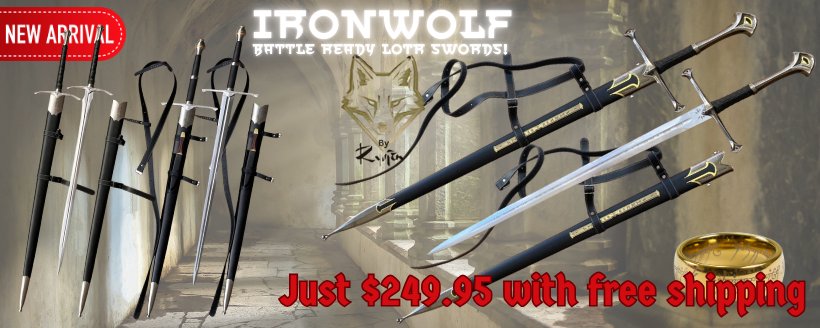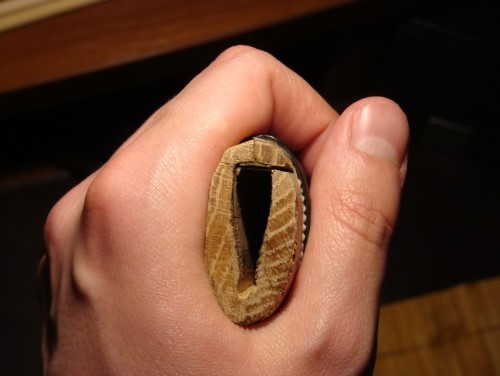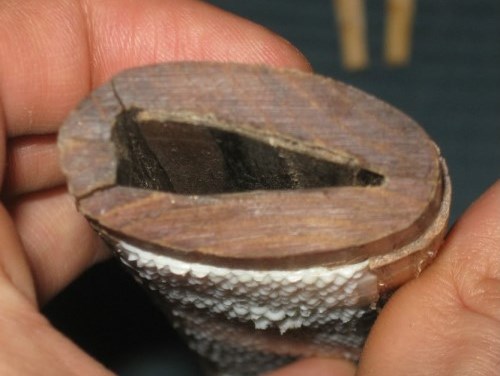The Practical Pro Katana
DISCONTINUED
This sword has been discontinued and is no longer in production or available, but is preserved on the site for informational purposes.
There is little doubt that Mark Mowrey's Review of the Practical Pro Katana is one of the best pictorial reviews of ANY sword on the internet - this guy certainly know his way around a camera!
And while Mark is a relative newcomer to collecting Japanese swords, his hands on review of the Practical Pro Katana gives anyone interested in this massive sword at least a very clear idea of what it looks like and how it handles.
Hanwei Practical Pro Katana Review
Review by Mark Mowrey, Ohio, USA
|
Steel Weight Point of Balance Price Range |
1095 Carbon Steel 3lbs 5.51" from tsuba US$389-519 |
The Cas Iberia website states "the Practical Pro Katana (SH2162) has an extended tsuka and a thicker and longer blade." They aren't kidding, this sword is big. It feels massive as it is drawn from the saya.
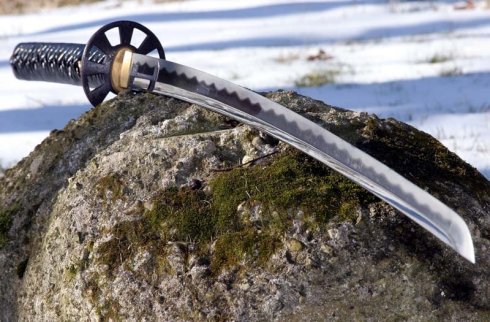
Looking at the Practical Pro in a photo by itself, it is hard to determine the size. It is best illustrated in a side-by-side photo. The only other sword I (currently) have is the Cheness Kaze Katana. I assume the Kaze can be considered to have the dimensions of a standard sized katana. (Editors note: the assumption is correct!)
The two swords are aligned at the tsuba. The tsuka on the Pro is about 4 inches longer than that of the Kaze and a bit thicker.
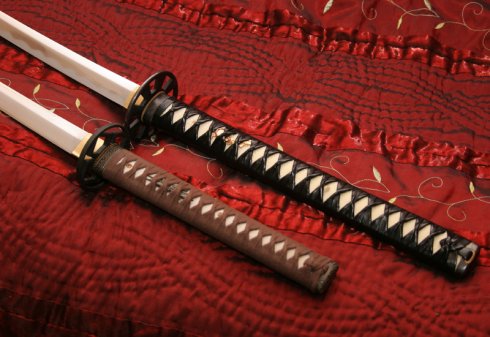 Comparison with the Cheness Kaze Katana
Comparison with the Cheness Kaze KatanaThe blade length is about 1.5 inches longer with a shorter kissaki (tip of the blade).
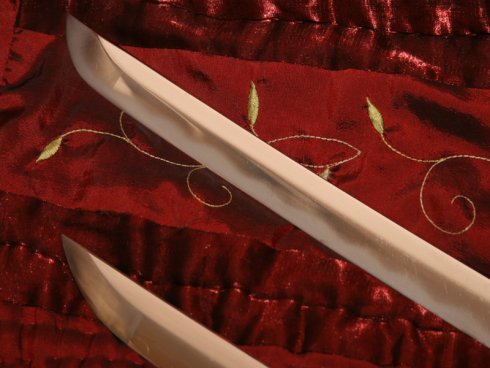
With this increased size, the Practical Pro Katana is of course heavier than the Kaze. My Kaze weighs in at 2.5 lbs while the Pro weighs 2.9 lbs. This extra weight is deceiving though. I think the majority of the weight is in the extended tsuka. This makes the Pro feel lighter because it is better balanced. I suppose another way to say this is that the Kaze feels blade heavy after handling the Practical Pro Katana. I have no formal sword training so I am unable to provide a "proper" review in regards to "proper" handling and technique.
The tsuka of the Pro is wrapped with a synthetic black leather ito. It looks nice but I don't care for the feel of it. The folds of the ito seem to protrude quite a bit and can be hard on the hand. I would think that the synthetic leather could get slippery if your hands become sweaty from an extended battle with evil foam pool noodles.
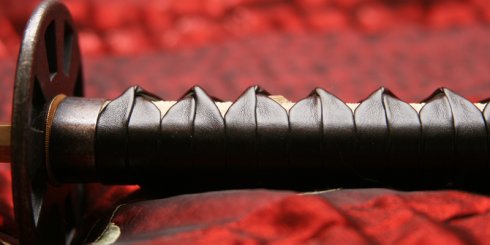
The koshirae (fittings) are antiqued black iron, simple, and look nice. I cannot tell what the menuki (ornaments) are or what they are made of. They feel kind of plastic like when I tap on them.
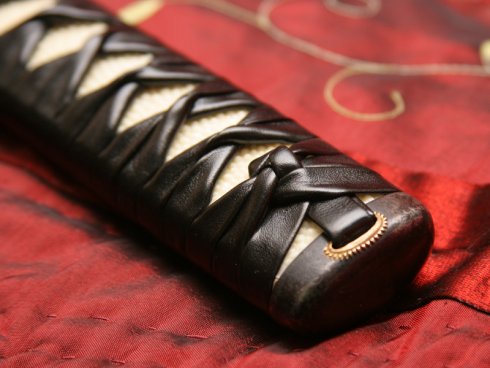
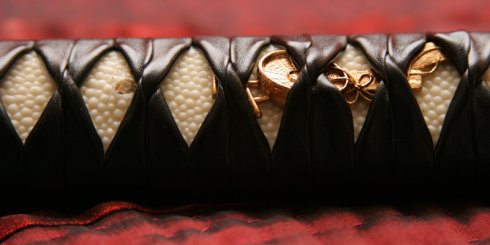
The blade of the Practical Pro Katana also has a greater sori (curvature) than the Kaze. The sori of the Kaze measures 0.5 inches. The Pro's greater sori of 0.7 inches would most likely assist in cutting.
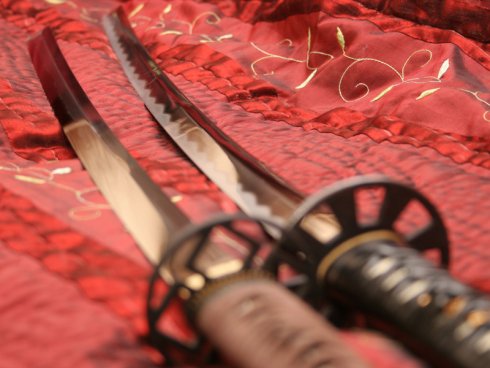
The Practical Pro Katana is differentially tempered using a traditional claying method. The hamon is very prominent. It is a regular, wavy pattern. Notare style, perhaps? The hamon has a satin finish compared to the high polish of the rest of the blade. This contrasts the straight hamon of the Kaze that seems to have a mirror finish.
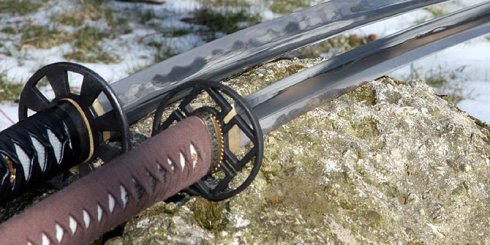
The blade of the Practical Pro feels sharp, knife blade kind of sharp. It almost feels as though there is a secondary bevel but I can't be certain. The Kaze cuts through a hand held piece of paper more smoothly though and it does not feel as sharp. Don't worry; they were gentle cuts, not swings. My fingers were safe. As discussed in posts on the SBG Forum, sharpness of katana can be deceiving due to the different shapes of a blade bevels.
I also noticed that the blade's curve at the ha (edge) was not smooth. It has a "bump" in it as shown in the photo below. I would not consider this a flaw or lack of quality control. I think of it as reminder that these swords are hand made.
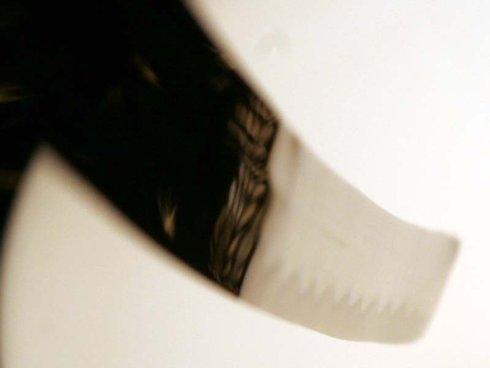
Upon disassembly, I became bit concerned about how easily the Practical Pro came apart. The mekugi nearly fell out with the lightest of taps. The tsuka and other fittings slid off easily as well. I had to pound the tsuba with a rubber mallet to get the Kaze apart.
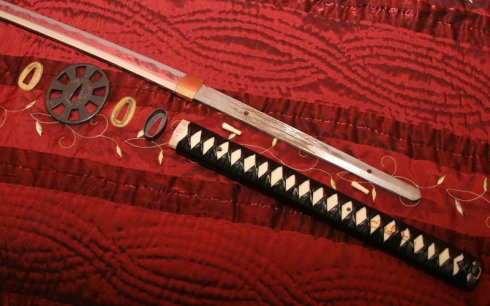
There appears to be thin layers of wood in the tsuka of the Practical Pro. I imagine this is to tighten up fit of the tsuka on the nakago (tang). When assembled, the PPK feels solid with nothing loose. Maybe the ease to disassemble it is not an issue.
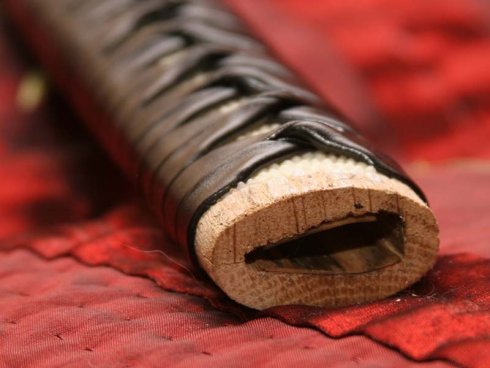
EDITORS NOTE
In truth, the Practical Pro that Mark received was very well assembled. In two other reviews on the SBG forums the tsuka was on too tightly, and both tsuka were cracked..
This is not the end of the world, and certainly not limited to this sword. For more information on this widepread issue check our article: Cracked Tsuka The Scourge of Production Swords?
The habaki (blade collar) has been fitted to the blade nicely.
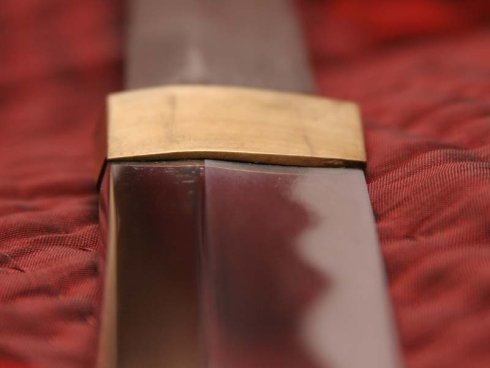
The nakago is marked with HW. I assume this is for Hanwei.
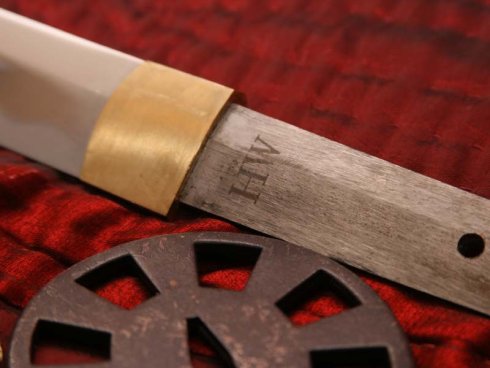
Over all, the Hanwei Forge Practical Pro Katana is great if you are looking for a larger sword. Even though it is big, it feels well balanced and good in the hand. It will certainly look great as a display piece as well. The only change I would make is to remove the synthetic leather ito and replace it with cotton or silk.
I don't know that I will be keeping this sword. It is a bit big for my 5'9" frame. I will most likely be listing it on eBay in the near future. I am sure it will find a good home with someone looking for a larger katana.
PROS
- Decently tempered 1095 differentially hardened blade
- Iron Tsuba, Fuchi and Kashira fittings
- Massive tsuka for extra cutting leverage (long tsuka swords like this were often historically used for test cutting on condemned criminals)
CONS
- Synthetic Ito feels somewhat slippery and uncomfortable on the hands
- Hamon is real but buried under acid etch
- Quality control issues
WHERE TO BUY
Sadly the Practical Pro Katana, along with the entire Hanwei line up came to a halt in late 2024 with the closure of the factory. However, the original design and the original design TEAM are planning a re-release of this sword VERY soon. So stay tuned, this swords story is not yet at an end...
I hope you enjoyed this Pictoral review of the Practical Pro Katana as much as I did. To return to A Beginners Guide to Authentic Japanese Swords, from The Practical Pro Katana Reviewed, click here

Buying Swords Online Can Be DANGEROUS!
Find the Best Swords in the:
Popular & Recommended ARTICLES

The ONLY true free online magazine for sword enthusiasts. Delivered once a month on the 1st day of the month, no filler and no BS, just the latest sword news & info delivered straight to your inbox.

